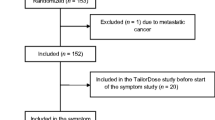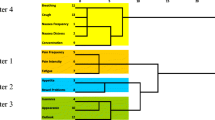Abstract
Goals of work
The aim of this secondary data analysis was to investigate symptom clusters over time for symptom management of a patient group after commencing adjuvant chemotherapy.
Materials and methods
A prospective longitudinal study of 219 cancer outpatients conducted within 1 month of commencing chemotherapy (T1), 6 months (T2), and 12 months (T3) later. Patients' distress levels were assessed for 42 physical symptoms on a clinician-modified Rotterdam Symptom Checklist. Symptom clusters were identified in exploratory factor analyses at each time. Symptom inclusion in clusters was determined from structure coefficients. Symptoms could be associated with multiple clusters. Stability over time was determined from symptom cluster composition and the proportion of symptoms in the initial symptom clusters replicated at later times.
Main results
Fatigue and daytime sleepiness were the most prevalent distressing symptoms over time. The median number of concurrent distressing symptoms approximated 7, over time. Five consistent clusters were identified at T1, T2, and T3. An additional two clusters were identified at 12 months, possibly due to less variation in distress levels. Weakness and fatigue were each associated with two, four, and five symptom clusters at T1, T2, and T3, respectively, potentially suggesting different causal mechanisms.
Conclusion
Stability is a necessary attribute of symptom clusters, but definitional clarification is required. We propose that a core set of concurrent symptoms identifies each symptom cluster, signifying a common cause. Additional related symptoms may be included over time. Further longitudinal investigation is required to identify symptom clusters and the underlying causes.
Similar content being viewed by others
References
Kirkova J, Walsh D (2007) Cancer symptom clusters—a dynamic construct. Support Care Cancer 15(9):1011–1013. doi:10.1007/s00520-007-0259-2
Cooley ME (2000) Symptoms in adults with lung cancer: a systematic research review. J Pain Symptom Manage 19(2):137–153. doi:10.1002/pon.694
Cooley ME, Short TH, Moriarty H (2003) Symptom prevalence, distress, and change over time in adults receiving treatment for lung cancer. Psycho-Oncol 12(7):694–708. doi:10.1002/pon.694
Doorenbos A, Verbitsky N, Given B, Given C (2005) An analytic strategy for modeling multiple-item responses. Nurs Res 54(4):229–234
Dodd MJ, Janson S, Facione N, Faucett J, Froelicher ES, Humphreys J, Lee KA, Miaskowski C, Puntillo K, Rankin S, Taylor D (2001) Advancing the science of symptom management. J Adv Nurs 33(5):668–676
Miaskowski C (2006) Symptom clusters: establishing the link between clinical practice and symptom management research. Support Care Cancer 14(8):792–794. doi:10.1007/s00520-006-0038-5
Kim H-J, McGuire DB, Tulman L, Barsevick A (2005) Symptom clusters: concept analysis and clinical implications for cancer nursing. Cancer Nurs 28(4):270–282
Dodd MJ, Miaskowski C, Paul SM (2001) Symptom clusters and their effect on the functional status of patients with cancer. Oncol Nurs Forum 28(3):465–470
Butt Z, Wagner LI, Beaumont JL, Paice JA, Strauss JL, Peterman AH, Carro G, Von Roenn JH, Shevrin JH, Cella D (2008) Longitudinal screening and management of fatigue, pain, and emotional distress associated with cancer therapy. Support Care Cancer 16(2):151–159. doi:10.1007/s00520-007-0291-2
Byar K, Berger AM, Bakken S, Cetak M (2006) Impact of adjuvant breast cancer chemotherapy on fatigue, other symptoms, and quality of life. Oncol Nurs Forum 33(1):E18–E26
Kim H-J, Barsevick A, Tulman L, McDermott P (2008) Treatment-related symptom clusters in breast cancer: a secondary analysis. J Pain Symptom Manage 36(5):468–479. doi:10.1016/j.jpainsymman.2007.11.011
Cronbach LJ, Shavelson RJ (2004) My current thoughts on coefficient alpha and successor procedures. Educ Psychol Meas 64(3):391–418. doi:10.1177/0013164404266386
Gleason JF Jr, Case D, Rapp SR, Ip E, Naughton M, Butler JM Jr, McMullen K, Stieber V, Saconn P, Shaw EG (2007) Symptom clusters in patients with newly-diagnosed brain tumors. J Support Oncol 5(9):427–436
Kim E, Jahan T, Aouizerat B, Dodd M, Cooper B, Paul S, West C, Lee K, Swift P, Wara W, Miaskowski C (2009) Changes in symptom clusters in patients undergoing radiation therapy. Support Care Cancer 17(11):1383–1391. doi:10.1007/s00520-009-0595-5
Chow E, Fan G, Hadi S, Filipczak L (2007) Symptom clusters in cancer patients with bone metastases. Support Care Cancer 15(9):1035–1043. doi:10.1007/s00520-007-0241-z
Chow E, Fan G, Hadi S, Wong J, Kirou-Mauro A, Filipczak L (2008) Symptom clusters in cancer patients with brain metastases. Clin Oncol 20(1):76–82. doi:10.1016/j.clon.2007.09.007
Hird A, Wong J, Zhang L, Tsao M, Barnes E, Danjoux C, Chow E (2009) Exploration of symptoms clusters within cancer patients with brain metastases using the Spitzer Quality of Life index. Support Care Cancer. doi:10.1007/s00520-009-0657-8
Chen M-L, Lin C-C (2007) Cancer symptom clusters: a validation study. J Pain Symptom Manage 34(6):590–599. doi:10.1016/j.jpainsymman.2007.01.008
Chen M-L, Tseng H-C (2006) Symptom clusters in cancer patients. Support Care Cancer 14(8):825–830. doi:10.1007/s00520-006-0019-8
Gift AG, Jablonski A, Stommel M, Given CW (2004) Symptom clusters in elderly patients with lung cancer. Oncol Nurs Forum 31(2):203–210. doi:10.1188/04.ONF.203-212
Gift AG, Stommel M, Jablonski A, Given C (2003) A cluster of symptoms over time in patients with lung cancer. Nurs Res 52(6):393–400
Wang XS, Fairclough DL, Liao Z, Komaki R, Chang JY, Mobley GM, Cleeland CS (2006) Longitudinal study of the relationship between chemoradiation therapy for non-small cell lung cancer and patient symptoms. J Clin Oncol 24(27):4485–4491. doi:10.1200/JCO.2006.07.1126
Tong H, Isenring E, Yates P (2009) The prevalence of nutrition impact symptoms and their relationship to quality of life and clinical outcomes in medical oncology patients. Support Care Cancer 17(1):83–90. doi:10.1007/s00520-008-0472-7
Osborne J, Costello AB, Kellow JT (2008) Best practices in exploratory factor analysis. In: Osborne J (ed) Best practices in quantitative methods. Sage, Thousand Oaks, CA, pp 86–124
Hadi S, Fan G, Hird AE, Kirou-Mauro A, Filipczak LA, Chow E (2008) Symptom clusters in patients with cancer with metastatic bone pain. J Pall Med 11(4):591–600. doi:10.1089/jpm.2007.0145
Hadi S, Zhang L, Hird A, de Sa E, Chow E (2008) Validation of symptom clusters in patients with metastatic bone pain. Curr Oncol 15(5):211–218
Pett MA, Lackey NR, Sullivan JJ (2003) Making sense of factor analysis: the use of factor analysis for instrument development in health care. Sage, Thousand Oaks, CA
Cattell RB (1966) The scree test for the number of factors. Multivariate Behav Res 1:245–276
Zwick WR, Velicer WF (1986) Comparison of five rules for determining the number of components to retain. Psychol Bull 99(3):432–442
O'Connor BP (2000) SPSS, SAS, and MATLAB programs for determining the number of components using parallel analysis and Velicer's map test. Behav Res Meth Instrum Comput 32(3):396–402
Thurstone LL (1947) Multiple factor analysis, 2nd edn. University of Chicago Press, Chicago
Hogarty KY, Hines CV, Kromrey JD, Ferron JM, Mumford KR (2005) The quality of factor solutions in exploratory factor analysis: the influence of sample size, communality, and overdetermination. Educ Psychol Meas 65(2):202–226. doi:10.1177/0013164404267287
Bandalos DL, Finney SF (2010) Factor analysis: exploratory and confirmatory. In: Hancock GR, Mueller RO (eds) The reviewer's guide to quantitative methods in the social sciences (electronic resource). Routledge, Hoboken, pp 93–114
Skerman HM, Yates PM, Battistutta D (2009) Multivariate methods to identify cancer-related symptom clusters. Res Nurs Health 32(3):345–360. doi:10.1002/nur.20323
Ivanova MO, Ionova TI, Kalyadina SA, Uspenskaya OS, Kishtovich AV, Hong Guo MS, Mendoza TR, Novik A, Cleeland CS, Wang XS (2005) Cancer-related symptom assessment in Russia: validation and utility of the Russian M. D. Anderson Symptom Inventory. J Pain Symptom Manage 30(5):443–453. doi:10.1016/j.jpainsymman.2005.04.015
Williams PD, Ducey KA, Sears AM, Williams AR, Tobin-Rumelhart SE, Bunde P (2001) Treatment type and symptom severity among oncology patients by self-report. Int J Nurs Stud 38(3):359–367. doi:10.1016/S0020-7489(00)00067-5
Lenz ER, Pugh LC, Milligan RA, Gift A, Suppe F (1997) The middle-range theory of unpleasant symptoms: an update. Adv Nurs Sci 19(3):14–27
Matsuda T, Takayama T, Tashiro M, Nakamura Y, Ohashi Y, Shimozuma K (2005) Mild cognitive impairment after adjuvant chemotherapy in breast cancer patients—evaluation of appropriate research design and methodology to measure symptoms. Breast Cancer 12(4):279–287
Andrykowski MA, Donovan KA, Jacobsen PB (2009) Magnitude and correlates of response shift in fatigue ratings in women undergoing adjuvant therapy for breast cancer. J Pain Symptom Manage 37(3):341–351. doi:10.1016/j.jpainsymman.2008.03.015
Gapstur RL (2007) Symptom burden: a concept analysis and implications for oncology nurses. Oncol Nurs Forum 34(3):673–680. doi:10.1188/07.ONF.673-680
Acknowledgment
This research has been supported by funding from a QUT Postgraduate Research Award.
Conflict of interest
None.
Author information
Authors and Affiliations
Corresponding author
Rights and permissions
About this article
Cite this article
Skerman, H.M., Yates, P.M. & Battistutta, D. Cancer-related symptom clusters for symptom management in outpatients after commencing adjuvant chemotherapy, at 6 months, and 12 months. Support Care Cancer 20, 95–105 (2012). https://doi.org/10.1007/s00520-010-1070-z
Received:
Accepted:
Published:
Issue Date:
DOI: https://doi.org/10.1007/s00520-010-1070-z




